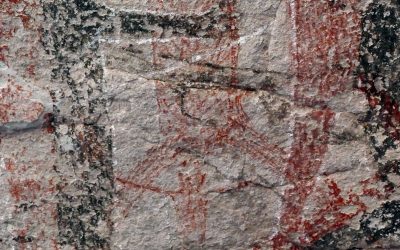Going Back in Time

A bit over three hours after leaving the paved road, our four wheel drive truck surged up a steep embankment and stopped in a small corral that was shaded by a few large mesquites.
Stepping out of the truck was a step back in time. The wood rail corral was leaning into the surrounding trees, and there was nothing in sight to dissuade us from thinking it was 1880. A few steers and cows, with ribs showing, perked up as we walked toward the gate. Once they determined that we weren’t carrying feed or branding irons they wandered away, quickly disappearing into the scrub and cactus.
The path we followed was rough, and carpeted with the evidence the cows benefit from a diet high in fiber. For a few minutes we hiked along the floor of the canyon, where water flowed among the rocks and into pools that were obviously the reason the cattle were nearby. In this desert climate, water is everything.
After fording the stream several times, back and forth, we began to climb the rocky side of the canyon, and after about 30 minutes we arrived under a high, overhanging rock ceiling.
A sweaty pause, a sip of water, and as our eyes dilated a bit in the dim light of the cave, gasps of amazement. The rock overhead was covered with paintings, mostly of humans. Large paintings, between six and twelve feet high, painted on a surface that was well beyond our reach. Some of the figures were all red, most were half red and half black, a few were decorated with vertical and horizontal lines and many were pierced through with arrows or spears. Most of the red/black figures were obviously male, and most of the all red figures were female, one apparently giving birth.
We laid on the dirt floor and consumed the sights above us. So many paintings! A few overlaid others in the crowed rock canvas. And as we looked, we began to try and understand what we were seeing. Are these memorials to tribal members who had died, either in battle or childbirth? Were these created as a supplication that none of the events foretold in paint would come to pass? Were they intended to threaten others who might pass by that these were a fierce people not to be disdained?
At about this point I began to realize that the more we understood about the people who created these paintings, and the carved pictographs that we had seen the day before, the more questions we had. And I also realized that was a pretty cool thing! In our modern world we have answered away the mysteries that send us on quests.
Aboard Catalyst and Westward we ask questions all day long; why do whales jump like that? Why do porpoises like to ride on the bow? Why do the grey whales of the Baja birthing lagoons bring their babies to our skiffs and lift them up so we can pet them? How do humpback whales communicate the complex choreography needed to execute a bubble net?
The answers to all of these questions is that we don’t know. No one does.
Isn’t that great!!
